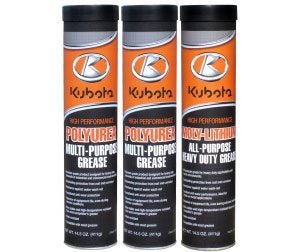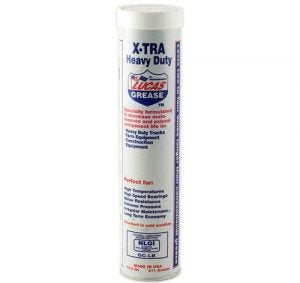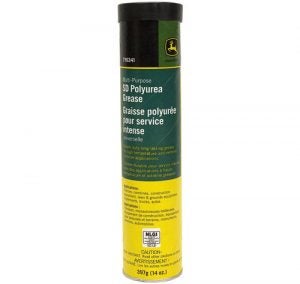Proper grease selection along with a good PM checklist leads to savings down the road.
Tractors with their many metal-on-metal joints, bearings, and oscillation points, operating at a wide range of temperatures in dusty, dirty and often wet conditions, require lubricants at those points to help prevent premature wear, corrosion, and failure. Grease, with use dating as far back as the Egyptians on chariot axles, is a common, inexpensive method of lubrication.
So what is this miracle lubricant? Grease is nothing more than a heavy oil with soap (frequently) to make it thick and clingy enough to remain in place. In this article, we’ll include a primer on grease grading and testing, some different types to consider, identification of tractor grease points, and frequency of lubrication to help set up a preventive maintenance (PM) program.
Grading, Testing, and Types

Grease is graded/rated by standards put in place by the National Lubrication Grease Institute (NLGI) and confirmed/validated by American Society for Testing and Materials (ASTM) standards. The consistency of grease is determined by a test that places a penetrometer (funnel) on a smooth cup of grease at 77F and measures the penetration in 1/10mm after five seconds. The greater penetration the softer the grease/the lesser the harder the grease, with corresponding lower and higher NLGI numbering. NLGI gives grease nine grades: 000, 00, 0, 1, 2, 3, 4, 5 and 6, with 000 being a high penetration formulation for use in centralized systems used in colder temperatures and 6 being a low penetration formula used in more heat-stressed conditions. Most greases today fall into the middle NLGI 1, 2, and 3 grades, with NLGI 2 being the most common.
ASTM test standards used include Timken OK load (performance measurement of extreme pressure additives), drop point (temperature grease passes from semi-solid to liquid state), water washout (resistance of the grease to water washout), oil separation (tendency to separate at elevated temperatures), corrosion prevention and wear. The test standards are technical and not completely necessary for a user of grease to be familiar with, but each helps define the grease’s performance and quality.
Greases generally fall within two families: those that use soap as a thickener and those that use thickeners that are non-soap based. Approximately 90 percent of the greases available fall within the soap thickener family. Formulation percentages generally are 80 percent to 95 percent oil, 2 percent to 20 percent soap thickener, and 0 percent to 15 percent percent additives. Thickeners used include calcium, sodium, barium, lithium, lithium complex, calcium complex, aluminum complex, clay, polyurea, and calcium sulfonate. Additives improve the grease’s performance under a variety of conditions and include antioxidants, antifoam agents, anti-wear agents, rust inhibitors, and corrosion inhibitors. As important as thickeners and additives are, the base oil and its viscosity ultimately determines the grease’s performance.

Types of base oils used include mineral oils (paraffinic and naphthenic), synthetic (PAO, ester, PAG, and alkylbenzenes), natural (vegetable), and high-performance (silicones and fluorinated fluids). Most greases will be formulated using American Petroleum Institute (API) Group I and II base stocks. These are appropriate for most applications. In applications with extreme temperatures, or where extended time periods between greasing is desired, a synthetic base oil might be the best choice.
So which grease should you use? The best place to start as always is your owner’s manual. But even there, you may not find all the answers. For example, a John Deere owner’s manual might call out a John Deere Multi-purpose SD polyurea grease or a John Deere HD Lithium Complex grease as the preferred choices. Below that will be a comment that says if not using the preferred greases to be sure to use a general all-purpose grease with an NLGI grade No. 2 rating. With such a wide choice of NLGI grade No. 2 greases available, choosing the right grease for your tractor will be highly influenced by your particular operating conditions. Therefore, a good understanding of what grease manufacturers use and do is important, and why this article has spent so much focus here.
Grease Point Identification

Once a proper grease or greases (more on this later) has been selected, identifying the points to grease is equally important. Again, the best place to identify those grease points is in your owner’s manual. Virtually anything contained that turns, rubs, or oscillates against another metallic surface will require lubrication. Common points will be rotating driveshaft universal joints, mower deck spindles, steering components, loader pivot points, backhoe pivot points and hitch components. Places often overlooked can include controls such as joystick components, brake pedal linkages, along with the implements the tractor uses. Once those points have been identified, a handy spreadsheet checklist can help remind where those points are, as well as serve as a checklist for PM.
PM Frequency
The frequency of the preventative maintenance will be condition related, but it is important to know the manufacturer’s suggested intervals. Again, the owner’s manual is your friend. In it you may find suggested intervals during periods of normal usage of something like every 50 hours. In extreme mud and/or wet conditions, those intervals might be reduced to every 10 hours of use or daily, whichever comes first. Once grease points have been identified and a PM schedule developed, it’s still important for the operator to pay attention to variables that may change such as weather extremes, longer use times, and exposure to moisture and chemicals etc.

A note on zerks, those fittings patented by Oscar U. Zerk in 1929 and then licensed by the Alemite Corp. for production. Zerk, or alemite fittings, utilize a small bearing ball that gets pushed out of the way by grease gun pressure to allow grease in and then spring back sealing the fitting when the pressure is released. After greasing, it is important to wipe off the excess grease left outside the fitting so that at the next greasing, the grease gun does not push contaminants into the bearing or fitting. Forget this easy step, and premature failure will always follow.
Wrap Up
While in many industrial applications, the use of sealed bearings (bearings with a sealed reservoir designed to lubricate for the design-life of the bearing) and in grease-free fittings (often coated with polymers such as Teflon), has become more widespread, most tractors and their related implements still require a PM program that includes regular greasing to keep everything in top operating order. To get the most out of the tractor and the implements it uses, the operator needs to have a good understanding of this often overlooked and all too often simplified lubricant.
A version of this article was originally published here on our partner website Tractor.com. It has been updated and adapted for AGDAILY.


